Tết (Vietnamese Lunar New Year) is just around the corner, and as an overseas Vietnamese, it always tugs at my heartstrings a bit because I can’t always make it back home for the festivities.
Nevertheless, Tết holds a special place in the hearts of most Vietnamese.

Today, I want to give you a little glimpse into what Tết food looks like across Vietnam — from the North to the Central and the South. Each region celebrates with its own flavors and traditions, and that’s what makes Vietnamese Tết so special.
I’ve also gathered some of my favorite Tết recipes on the blog — not all of them are strictly traditional, but they’re all about one thing: bringing everyone together around good food and warm moments.
- Vietnamese Lunar New Year – Tết Nguyên Đán and Our Traditions
- Northern Dishes
- 1. Bánh Chưng (Square Sticky Rice Cake)
- 2. Nem Rán (Northern-style Fried Spring Rolls)
- 3. Gà Luộc (Boiled Chicken)
- 4. Giò Lụa (Vietnamese Pork Roll)
- 5. Giò Thủ (Vietnamese Head Cheese)
- 6. Thịt Đông (Vietnamese Meat Jelly / Aspic)
- 7. Xôi Gấc (Vietnamese Red Sticky Rice / Gac Fruit Sticky Rice)
- 8. Canh Bóng Thả (Pork Rind Soup)
- Central Dishes
- Southern Dishes
- Chinese-Vietnamese Dishes
- Non-Traditional (But Perfectly Tết-Worthy) Dishes
Vietnamese Lunar New Year – Tết Nguyên Đán and Our Traditions
Tết (or Tết Nguyên Đán) is Vietnam’s Lunar New Year — our most important and beloved celebration of the year.
It coincides with Chinese and Korean New Year, yet the way we celebrate Tết is truly our own, filled with beautiful customs and warm family traditions.
This festive season marks the arrival of spring according to the lunisonar calendar, usually falling between late January and mid-February.
It’s a time for family reunions, honoring our ancestors, and embracing new beginnings — which is why we fondly call it “Tết Đoàn Viên”, meaning “Reunion Tết.”

In Vietnam, we even say “Ăn Tết”, literally “to eat Tết,” because food lies at the heart of every celebration. From preparing festive dishes to sharing sweets and tea with loved ones, Tết is as much about taste as it is about togetherness.
My parents often tell me stories from their childhood during the post-war years, when life was tough and Tết was the only time kids got new clothes. Families would raise a pig all year long just for this occasion, saving it for the special dishes that mark the new year.
When it comes to sweets, Tết traditions are quite similar across the country. Every household prepares a mâm ngũ quả — a five-fruit tray — to offer prayers to the ancestors.

As families visit one another (Đi Chúc Tết), we welcome guests with mứt Tết (preserved and candied fruits), roasted seeds and nuts, and endless cups of tea.
But for savory dishes, the differences between the North, Central, and South truly shine through.
Being born in Nha Trang in the South Central Coast, with parents originally from the North, I feel so lucky to have grown up enjoying the best of both worlds — a delicious blend of regional Tết flavors that tells the story of Vietnam from top to bottom.
Northern Dishes
1. Bánh Chưng (Square Sticky Rice Cake)
In Vietnamese history, Bánh Chưng is said to have been created by Prince Lang Liêu during the Sixth Hùng Dynasty (around 1712–1632 BC).
Until today, it remains the most iconic and meaningful Tết dish — a true symbol of family, gratitude, and our connection to the earth.

In the North, Bánh Chưng is a must-have during Tết, while people in the South prefer Bánh Tét, its cylindrical cousin.
Both are made from sticky rice filled with mung beans and pork belly, but Bánh Chưng is wrapped in lá dong (phrynium leaves) and shaped into a square to represent the land.
Since lá dong is hard to find abroad, many overseas Vietnamese use banana leaves (lá chuối) instead — the flavor stays just as comforting.
In my family, we always make both Bánh Chưng and Bánh Tét, but my dad insists on placing Bánh Chưng on the ancestral altar — he says its square shape looks more elegant and traditional.

How to enjoy Bánh Chưng
In the North, people love Bánh Chưng with Dưa Hành (pickled shallots).
In the South, it’s all about Bánh Chưng or Bánh Tét with Củ Kiệu (pickled Chinese onions).
As for me? I adore eating Bánh Chưng with Dưa Món (pickled vegetables in fish sauce) — or sometimes even with Korean Kimchi for a fun East-meets-East twist!

2. Nem Rán (Northern-style Fried Spring Rolls)
Nem Rán — the crispy, golden fried spring rolls from Hanoi — are a Tết essential and one of the North’s most beloved festive dishes.
My friends up North always joke about spending half a day wrapping hundreds of Nem Rán for Tết — it’s both a labor of love and a family bonding ritual (with plenty of laughter in between).

The filling for Nem Rán is quite different from Chả Giò (the Saigon-style spring rolls). It’s a delicious mix of ground pork, wood ear mushrooms, mung bean sprouts, glass noodles, and a hint of fresh cilantro — all wrapped in rice paper and fried to golden perfection.
And don’t forget the Hanoi-style dipping sauce — that sweet, tangy, garlicky Nuoc Cham that makes every bite burst with flavor. Your taste buds will thank you!
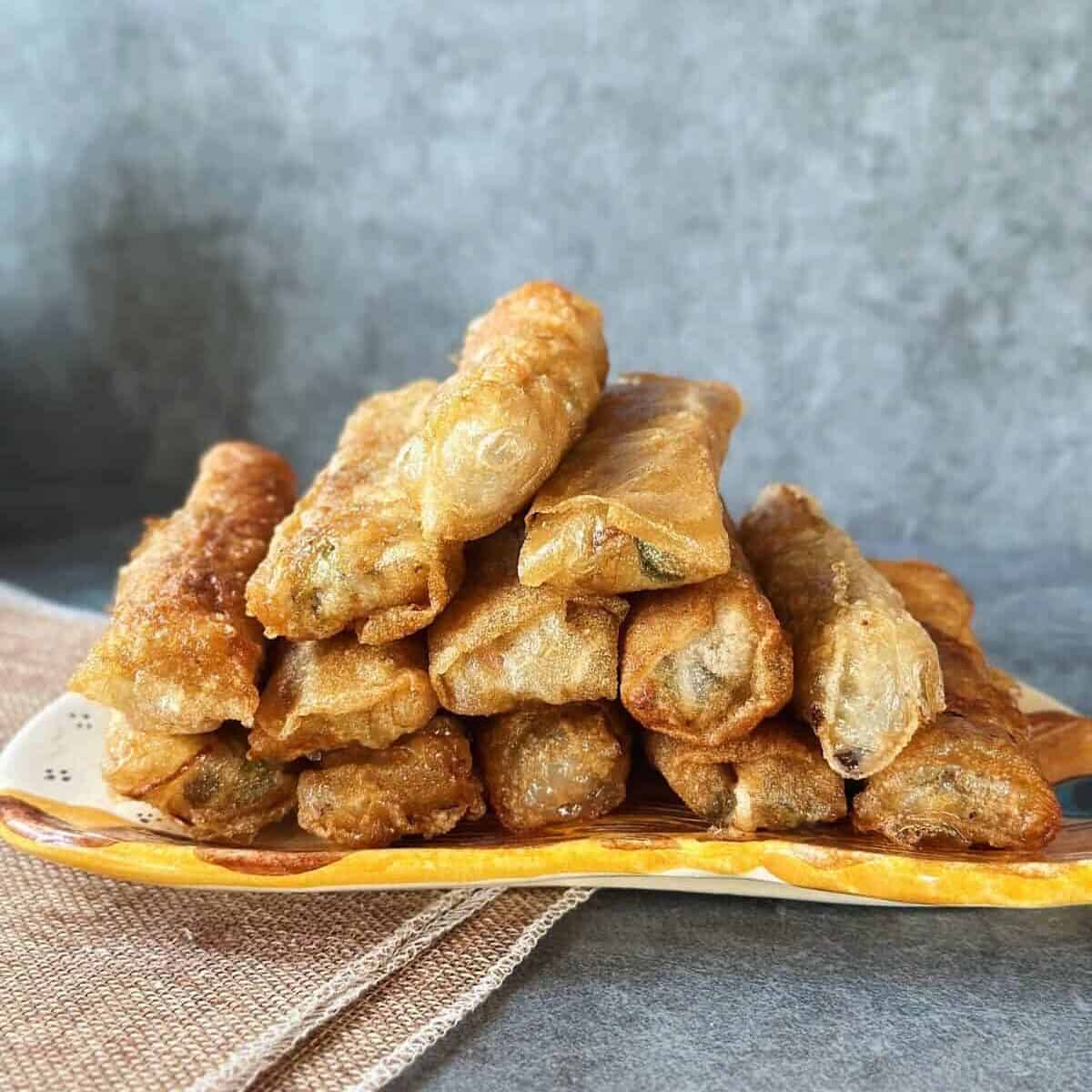
3. Gà Luộc (Boiled Chicken)
A beautifully golden, boiled chicken is more than just a dish — it’s a Tết symbol in Northern Vietnam, representing purity and the most heartfelt offering to our ancestors.

For Gà Luộc, we always go for gà đi bộ — free-range or “walking” chicken. The meat is firmer and slightly chewy, which we actually prefer over the soft, fall-apart texture of something like my Instant Pot Hainanese chicken rice.
To be honest, Gà Luộc isn’t everyone’s favorite since it can taste a bit plain. That’s why after Tết, you’ll often find plenty of boiled chicken leftovers — and that’s when Vietnamese moms get creative.
In the North, people often transform Gà Luộc into Bún Thang — a delicate noodle soup with chicken, Chả Lụa (Vietnamese pork sausage), and thinly sliced omelet — a clever way to make use of Tết leftovers.
In my family, my mom loves turning our Gà Luộc into Phở Gà (chicken pho), Cơm Gà (chicken and rice), Goi Ga (chicken salad), or even chicken spring rolls. Each dish tastes so comforting and full of Tết memories.
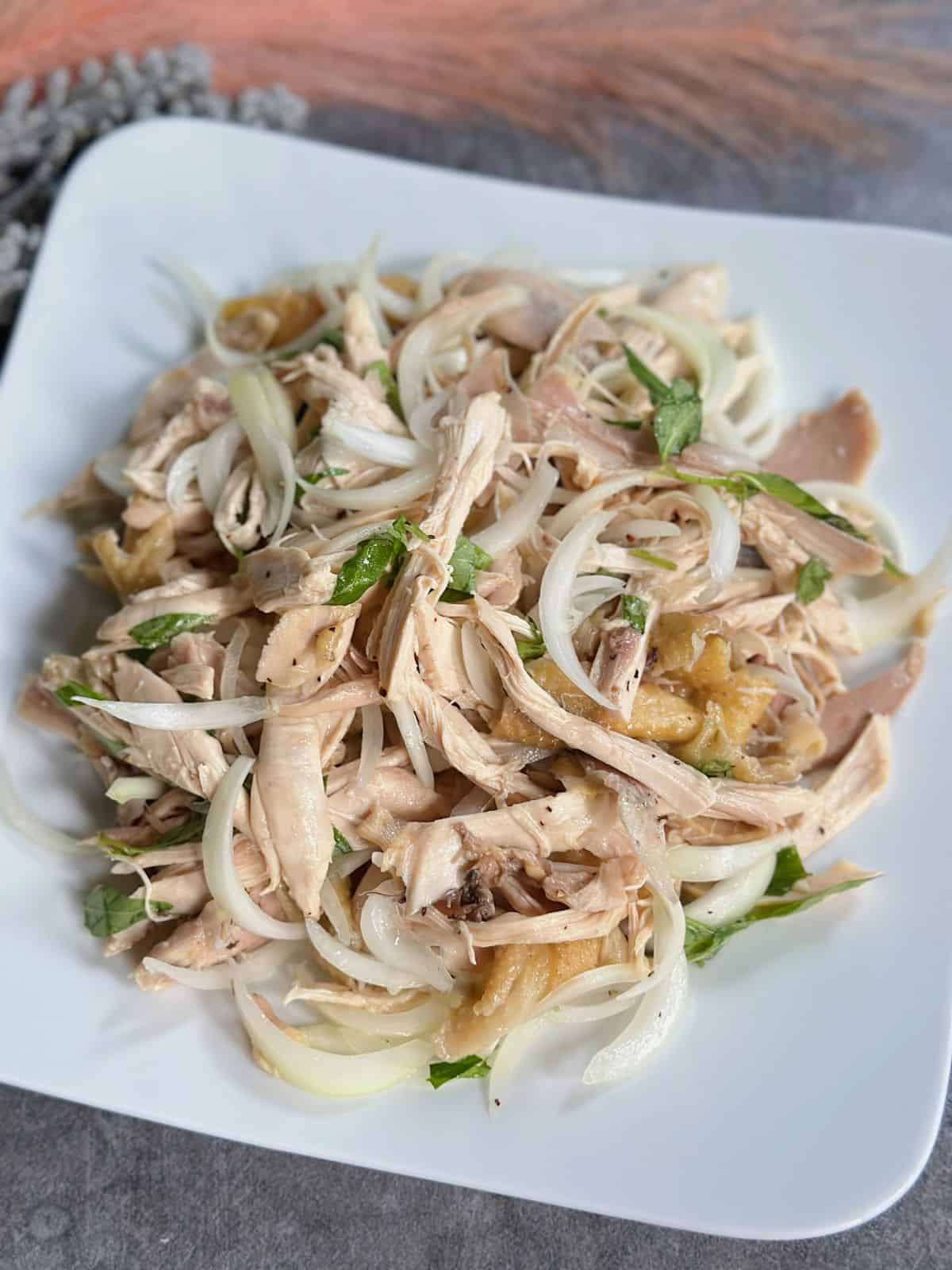
4. Giò Lụa (Vietnamese Pork Roll)
In the North, Giò Lụa is what Southerners call Cha Lua — both refer to the same silky-smooth Vietnamese pork roll, though the Northern version is usually a little less sweet.

Giò Lụa is one of those versatile dishes that just makes life easier during Tết. It’s perfect for family feasts, casual drinking snacks, or simply those busy days when no one feels like cooking.
You’ll also find it tucked inside Banh Mi sandwiches or served alongside Banh Cuon (steamed rice rolls). No matter how it’s enjoyed, Giò Lụa always brings that comforting, savory taste of home.

5. Giò Thủ (Vietnamese Head Cheese)
Giò Thủ, also known as Giò Xào, is another beloved and practical Tết dish in Northern Vietnam. The name says it all — “thủ” means “head,” while “xào” means “stir-fry.”

Back in the day, when families would butcher an entire pig to prepare for Tết, nothing went to waste. Giò Thủ was a clever way to use those tougher cuts — the ears, tongue, cheeks, and snout — and turn them into something delicious.
The meat is stir-fried with wood ear mushrooms, seasoned with fish sauce and lots of black pepper, then tightly wrapped in banana leaves and shaped into a neat cylinder.
Once cooled, it becomes beautifully firm and sliceable — the perfect savory treat to enjoy with pickles and a cup of tea during Tết.
6. Thịt Đông (Vietnamese Meat Jelly / Aspic)
Thịt Đông is Vietnam’s version of savory meat jelly — quite similar to zhū jiǎo dòng (猪脚冻) in Chinese Teochew cuisine or the aspic dishes you’ll find across Eastern Europe.
This dish is made with pork hocks, pork skin (or sometimes ears), wood ear mushrooms, and shiitake mushrooms. The natural gelatin from the pork skin is what makes the broth solidify into that beautiful, jiggly jelly once it cools.
Some families even make a chicken version, but they’ll usually add pork skin or a bit of gelatin to help it set properly.

My dad told me that when he was little, even though there were no refrigerators, the chilly Northern winter was enough to make thịt đông firm up naturally. It became a seasonal delicacy everyone looked forward to during Tết.
7. Xôi Gấc (Vietnamese Red Sticky Rice / Gac Fruit Sticky Rice)
Vietnamese people have countless ways to enjoy sticky rice — Xôi Mặn (Vietnamese sticky rice with savory toppings), Xôi Gà (chicken sticky rice), Xôi Lá Dứa (pandan sticky rice), Xôi Vò (mung bean sticky rice), and more.
But unlike in Thailand or Laos, in Vietnam, sticky rice is usually enjoyed for breakfast or special family occasions rather than as a main meal.
Among them all, Xôi Gấc — red sticky rice made with gấc fruit (baby jackfruit) — is the most iconic dish on the Tết table, especially in the North.

The gấc fruit is truly one of the most unique Vietnamese fruits. Its seeds are wrapped in a thick, bright red-orange membrane packed with lycopene and beta-carotene — both powerful antioxidants.
That’s what gives xôi gấc its stunning red-orange hue, naturally vibrant and festive.
In Vietnamese culture, red is the color of luck — symbolizing prosperity, happiness, and good fortune.
8. Canh Bóng Thả (Pork Rind Soup)
Canh Bóng Thả is a must-have traditional soup on every Tết banquet table in Hanoi.
This elegant, light soup has a clear, savory broth enriched with dried pork rind, juicy pork meatballs, and dried shrimp.
It’s also filled with shiitake mushrooms and beautifully carved vegetables like carrots, peas, broccoli, onions, and kohlrabi — turning it into a true feast for both the eyes and the palate.

Although it might look simple, Canh Bóng Thả takes hours of careful preparation — from soaking and cleaning each ingredient to simmering the broth just right.
Central Dishes
9. Chả Bò (Vietnamese Beef Roll)
Chả Bò — the beefy cousin of Chả Lụa — is a Tết favorite in Central Vietnam, especially around Đà Nẵng and Huế.

It has that signature bouncy, springy texture that reminds me of the Vietnamese beef balls often found in a steaming bowl of Phở Bò. Simple yet full of flavor, Chả Bò adds a savory, meaty touch to any Tết feast.
10. Thịt Heo Ngâm Nước Mắm (Cured Pork In Fish Sauce)
I honestly can’t figure out why Thịt Heo Ngâm Nước Mắm isn’t more loved among the Vietnamese diaspora — it’s that good!
Imagine the irresistible flavor of Korean marinated eggs (Mayak eggs), but in pork form and with fish sauce! That’s the kind of rich, savory umami magic this dish delivers.

In this dish, boiled pork belly is soaked in a sweet and savory fish sauce mixture that’s been briefly cooked. After resting for a day or two, the flavors fully develop — rich, salty-sweet, and deeply satisfying.
The best part? It can be stored at room temperature for weeks, making it perfect for the busy Tết season.
11. Nem Chua (Vietnamese Fermented Pork)
Nem Chua may have recently taken TikTok by storm, but for us Vietnamese, it’s been a longtime favorite — the ultimate nhậu snack to enjoy with a cold drink and good company.
This delicacy is made from fermented raw pork, known for its addictive balance of sour, sweet, and savory flavors.

Since it’s a raw fermented dish, cleanliness is absolutely key — any shortcuts can cause it to spoil easily. But when made right, it’s perfectly safe and incredibly tasty.
Some people even like to grill or pan-sear it lightly before eating, and honestly, the flavor only gets better that way.
Nem Chua is a specialty found in several regions across Vietnam — Thanh Hóa in the North Central, Nha Trang (my hometown) in the South Central, and Đồng Tháp in the Mekong Delta. The farther south you go, the sweeter the flavor becomes.
12. Dưa Món (Pickled Veggies in Fish Sauce Brine)
Dưa Món is a must-have during Tết, especially in Central Vietnam.
Think of it as a more festive cousin of Do Chua — it also features carrots and daikon, but the veggies are first sun-dried (or dehydrated) before being soaked in a rich fish sauce brine.

Southern Dishes
13. Bánh Tét (Cylindrical Sticky Rice Cake)
In Southern Vietnam, Bánh Tét is the star of Tết.
It’s quite similar to the Khmer Num Ansom and is the southern counterpart of Bánh Chưng. What makes Bánh Tét special is its versatility — it can be either savory or sweet.

The savory version comes with pork belly and mung beans at the center, wrapped snugly in layers of sticky rice.
Meanwhile, the sweet Bánh Tét, especially loved in the Miền Tây (Mekong Delta), is cooked with coconut milk and filled with sweetened mung bean paste or ripe banana.
14. Thịt Kho Tàu (Braised Pork with Eggs)
In Northern Vietnam, Thịt Kho Tàu is a cozy everyday comfort food. But in the South — especially in the Mekong Delta — it’s the heart of the Tết feast.
Southern families typically use pork belly and duck eggs, simmered slowly in sweet, savory coconut water until the sauce turns glossy and fragrant.
Every household makes a big pot a day or two before Tết, letting it rest and reheat over the following days — because truth be told, the more it’s reheated, the richer and deeper the flavor becomes.

Some kids might joke about getting “tired” of Thịt Kho Trứng during Tết, but honestly, it wouldn’t feel like Tết without it.
On my blog, you’ll find both styles — the Northern Thit Kho with its darker caramel color and fried eggs, and the Southern Thit Kho Trung version enriched with coconut water.
15. Canh Khổ Qua Dồn Thịt (Stuffed Bitter Melon Soup)
Among all Vietnamese vegetables, bitter melon is probably the most controversial one — you either love it or can’t stand it.
This comforting soup features bitter melon stuffed with a savory mix of ground pork, wood ear mushrooms, and bean thread noodles, all simmered in a light, clear broth.

In Vietnamese cuisine, canh (soups) made with fresh vegetables are a daily staple — from Canh Chua (sour soup with tamarind and okra) to Canh Bi Do (pumpkin soup). But Canh Khổ Qua takes on special meaning during Tết.
Why? Because “Khổ Qua” literally means “hardship passed.” Serving this soup at the start of the new year is like saying goodbye to the struggles of the old one — a deliciously symbolic way to begin fresh.
16. Củ Kiệu (Pickled Chinese Onions)
Just as Northerners enjoy Dưa Hành and folks in Central Vietnam love Dưa Món, we Southerners have our own favorite duo for Tết — Bánh Tét with Củ Kiệu (pickled Chinese onions) and Tôm Khô (dried shrimp).

Chinese-Vietnamese Dishes
In the vibrant streets of Saigon and the lush Mekong Delta, you’ll find a lively Chinese-Vietnamese (người Hoa) community that has deeply shaped our country’s food culture.
Most of them trace their roots back to Southern China — Cantonese (Quảng Đông), Teochew (Triều Châu), Hakka (Khách Gia), Hokkien (Phúc Kiến), and Hainanese (Hải Nam).

I used to live right in the heart of Saigon’s Chinatown, Chợ Lớn, where every corner buzzed with life, tradition, and the irresistible aroma of Chinese dishes.
The Chinese-Vietnamese community isn’t just a part of Vietnam — they’re a flavorful thread woven into our culinary identity, with their own festive dishes that make Lunar New Year even more special.
17. Bánh Tổ (Nian Gao / Chinese New Year Sweet Rice Cake)
Bánh Tổ, also known as Nian Gao (年糕) in Chinese, is a traditional sweet rice cake made from glutinous rice flour, brown sugar, and a hint of ginger.
In Vietnam, we call it Bánh Tổ — literally “Ancestor Cake” — a name that reflects its deep connection to family and ancestral offerings during Tết.

This treat isn’t just popular among the Chinese-Vietnamese community in the South — it’s also a cherished Tết specialty in Hội An, the charming ancient town in Central Vietnam.
Back in the 16th–17th centuries, during the era of the Nguyễn Lords, Hội An flourished as a major trading port welcoming merchants from China, Japan, India, and Europe. This blend of cultures didn’t just shape the town’s architecture — it flavored its cuisine too.
Both Bánh Tổ and Cao Lau (Hội An-style noodles with braised pork) beautifully capture that unique East-meets-West culinary story.
18. Bánh Pía (Teochew “Pia” Pastry)
Bánh Pía is a beloved sweet that traces its roots back to Teochew immigrants in Southern Vietnam. It features a beautifully flaky, layered crust — a bit like puff pastry — with a rich filling of mung bean paste and the unmistakable aroma of durian.
In Southern Vietnam, Bánh Pía is often enjoyed during festive occasions like Tết Nguyên Đán (Lunar New Year) and Tết Trung Thu (Mid-Autumn Festival). But these days, it’s no longer reserved for holidays — you’ll find it in local shops all year round.

Since Bánh Pía keeps well for weeks, I always recommend it as one of the must-try (and must-bring-home) Vietnamese souvenirs — right alongside Vietnamese coffee and Vietnamese chocolate — especially if you ever visit Saigon.
19. Lạp Xưởng (Lap Cheong / Chinese Sausage)
Lạp Xưởng (腊肠), the famous Cantonese-style Chinese sausage, has long been a staple in Saigon’s Chợ Lớn — home to a vibrant Cantonese community and countless delicious eats.

These sweet–savory sausages are made from pork and a blend of seasonings, then air-dried to develop that signature rich aroma.
You’ll often spot Lạp Xưởng in everyday Chinese-Vietnamese dishes like Xôi Lạp Xưởng (sticky rice with Chinese sausage), Bánh Bao (steamed buns) or Bo Bia (fresh spring rolls with sausage and jicama).
When Tết comes around, people love to grill or pan-steam Lạp Xưởng until glossy and fragrant — the perfect pairing for a cold beer or a cozy family feast.
20. Sủi Cảo (Jiaozi/Chinese Dumplings)
Sủi Cảo (Chinese dumplings) — or Jiaozi (餃子) as they’re called in Mandarin — are a must-have for Chinese New Year, especially in Northern China.
In Vietnam, we know them as Sủi Cảo or Bánh Chẻo, and they’ve also become a beloved Tết dish among many Chinese-Vietnamese families.

21. Thịt Heo Quay (Roasted Pork Belly)
Thit Heo Quay (roasted pork belly) is another must-have on the Lunar New Year table for many Chinese-Vietnamese families.
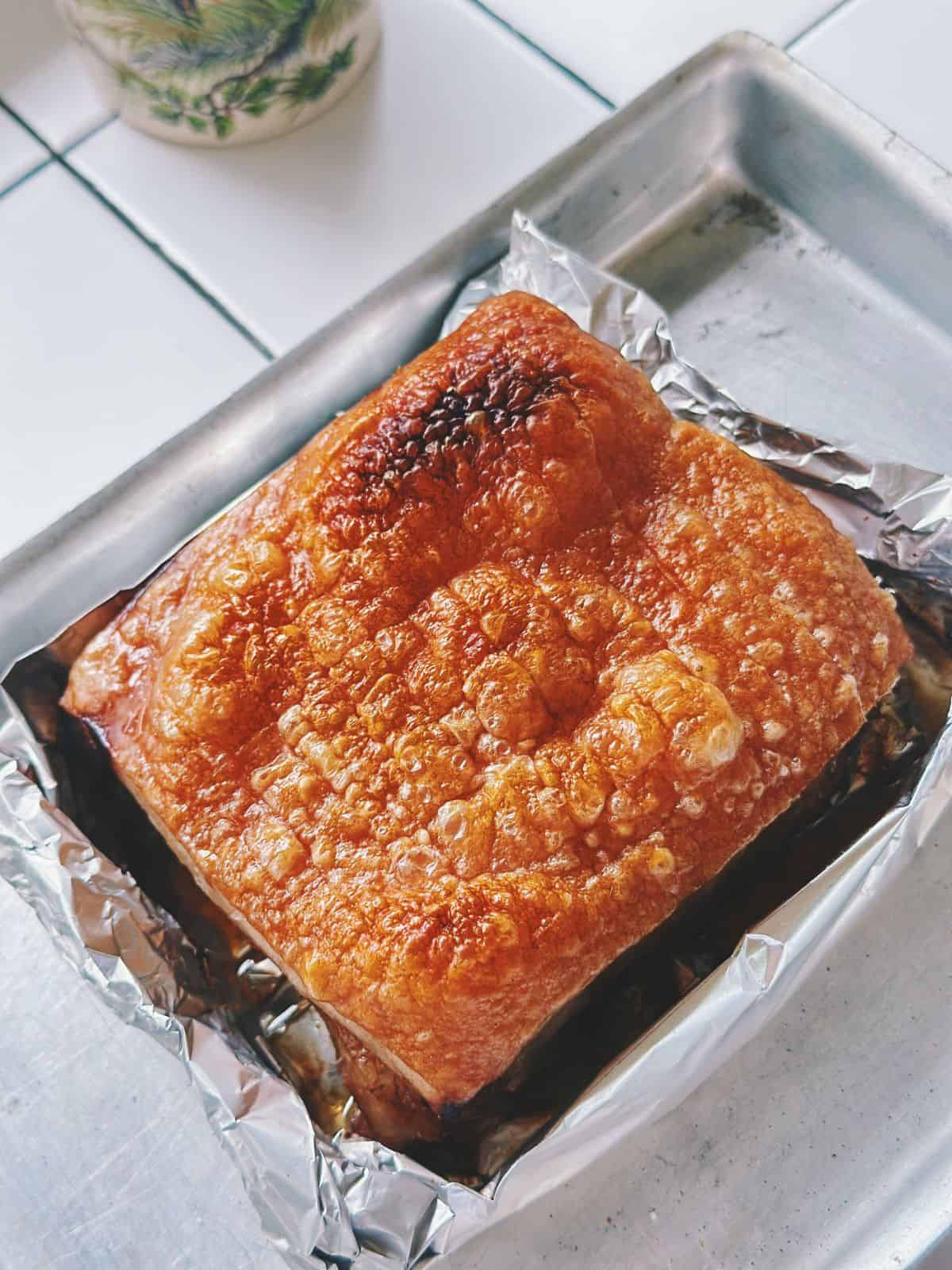
Some even go all out with a whole roast suckling pig — especially those running big family businesses.
In their tradition, offering a whole pig isn’t just about feasting; it’s a symbol of prosperity and good luck, often seen at grand celebrations, business openings, or spiritual ceremonies.
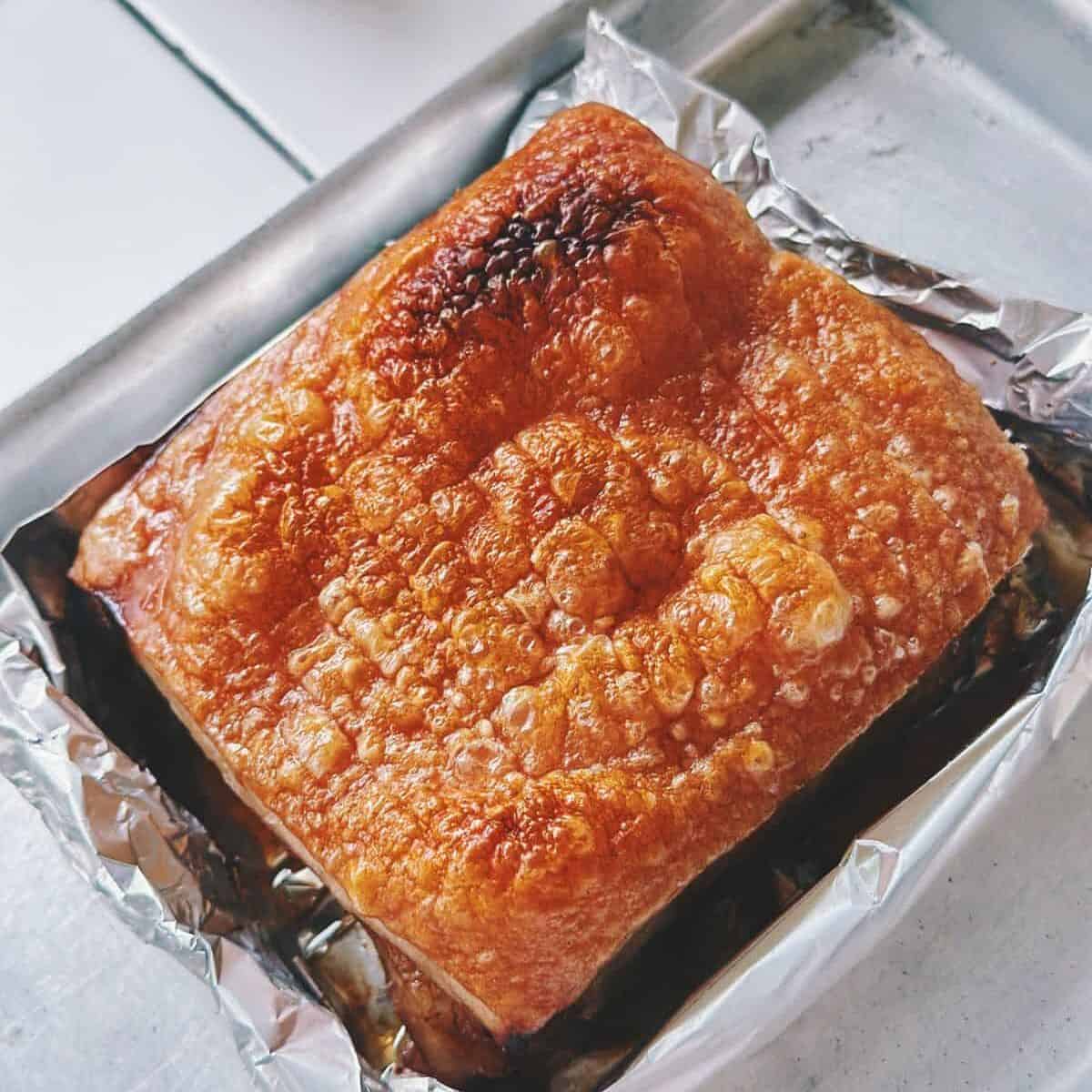
Non-Traditional (But Perfectly Tết-Worthy) Dishes
Living in Germany, where Tết isn’t an official holiday, makes it tricky to prepare all the traditional Vietnamese dishes. But honestly, that challenge is what inspired me to start Savour the Pho.
These recipes may not be classic Tết staples, but they’re ideal for busy families — and a fun way to bring something fresh and festive to your Tết potluck table.
22. Bánh Pate So (Vietnamese Pork Meat Pie)
Banh Pate So is a lovely French-Vietnamese fusion pastry that’s perfect as a snack, appetizer, or even for your Tết potluck table.
With its buttery, flaky crust and juicy, savory filling, it’s always a crowd-pleaser — and the best part? You can make it effortlessly with store-bought puff pastry.

23. Air Fryer Fish Sauce Chicken Wings
My air fryer fish sauce wings are the quick, guilt-free twist on the classic Cánh Gà Chiên Nước Mắm.
I like to call them Vietnamese finger-licking good — crispy wings coated in that sweet-salty fish sauce glaze that’s absolutely impossible to resist.

24. Lẩu (Vietnamese Hot Pot)
I’m not entirely sure if Lẩu counts as a traditional or non-traditional Tết dish — but one thing’s for sure: in Vietnam, almost every family enjoys a bubbling pot of hot pot during the festive season.
Whether it’s Chinese-style or Vietnamese-style, Lẩu is quick to prepare, especially if you use an instant hot pot base. Honestly, once you have hot pot, you can skip the appetizers and main courses altogether — it’s a full Tết feast on its own!
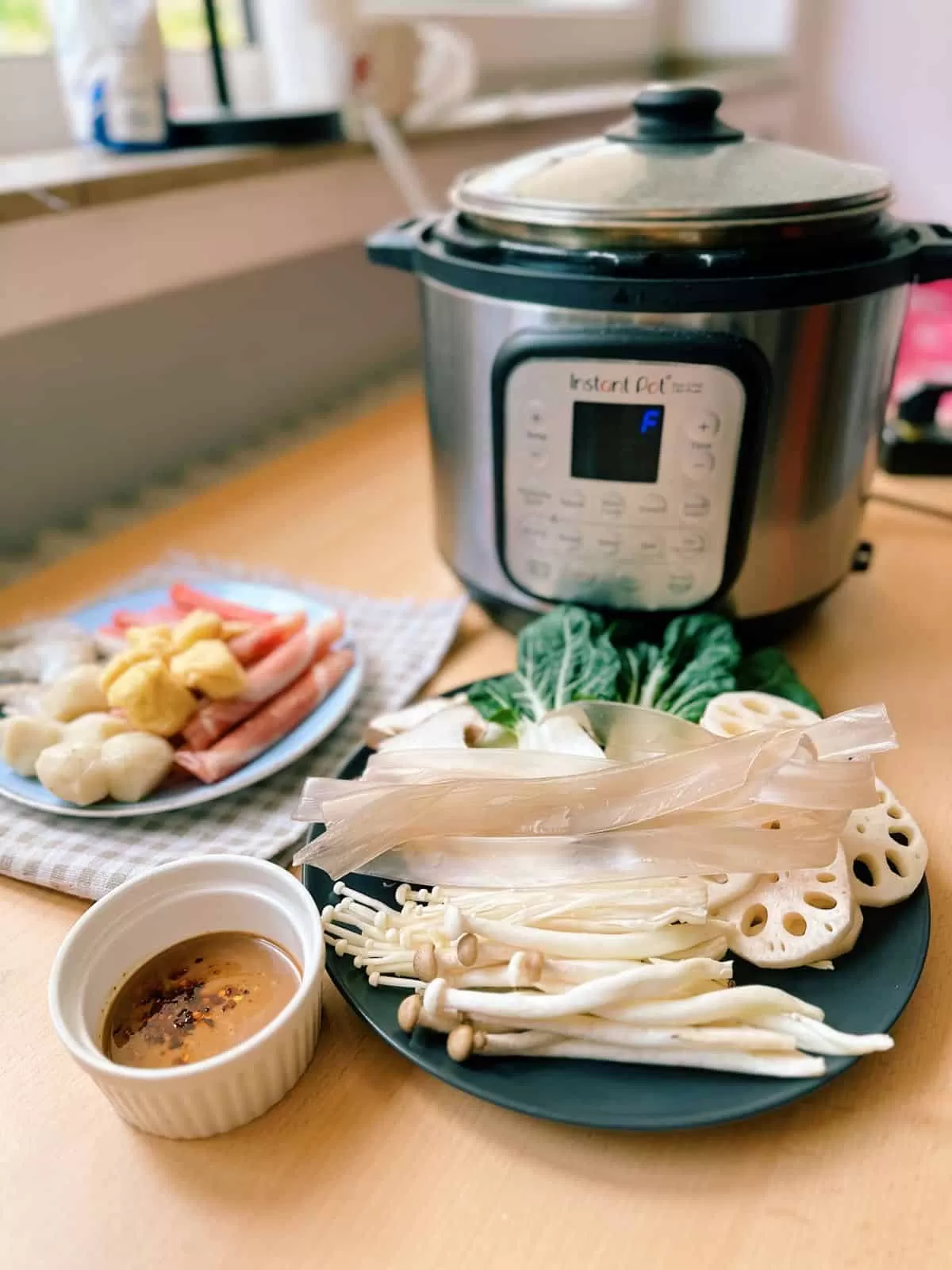
Traditionally, people use a special electric hot pot, but you can easily recreate the experience at home — just set up a single burner and pot, or try my favorite Instant Pot Hot Pot version for a cozy, fuss-free Lẩu night.
25. Banh Mi Charcuterie Board
My Banh Mi Charcuterie Board is basically a Bánh Mì feast turned party platter — colorful, fun, and effortlessly crowd-pleasing.
Vietnamese cold cuts are easy to find at most Asian markets, but you can always swap them with your favorite deli meats if options are limited.

Prepping Đồ Chua (pickled carrots and daikon) and Vietnamese mayo only takes a few minutes.
And if you have a bit more time, I highly recommend making my Vietnamese liver pate — it doubles perfectly for Bánh Patê Sô too. But if you’re short on time, your favorite store-bought pâté works just fine.

26. Gỏi Cuốn (Vietnamese Spring Rolls)
Gỏi Cuốn — Vietnamese spring rolls — aren’t just perfect for potlucks; they also make a fun, interactive, and wholesome meal for family gatherings.
I’ll show you how we Vietnamese turn Gỏi Cuốn into a fun rice paper roll feast.
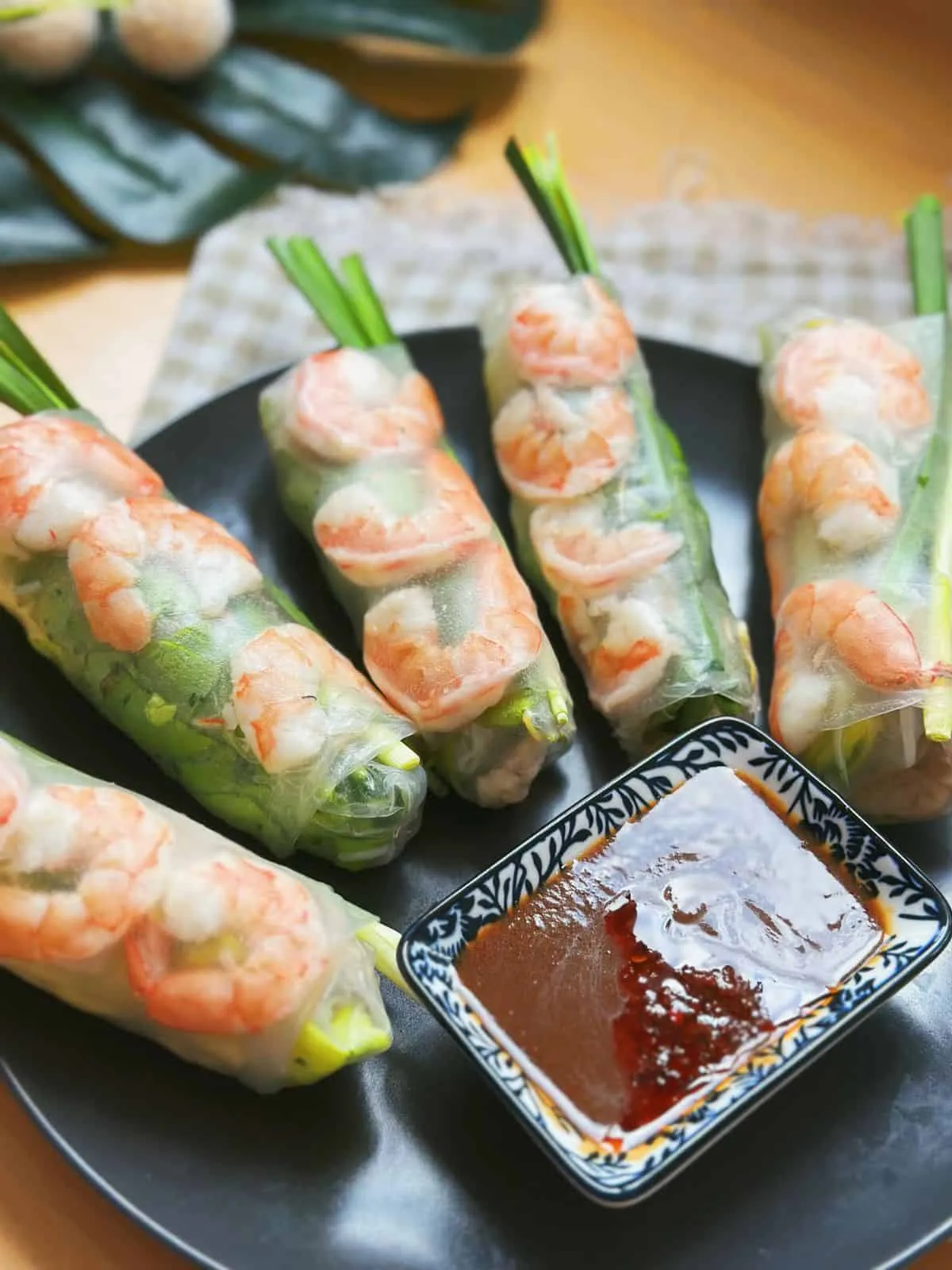
Here’s what you need:
- Rice papers (Bánh Tráng) and a few bowls of room-temperature water
- Lettuce and fresh Vietnamese herbs like Thai basil, mint, and perilla leaves
- Fillings — think boiled pork belly, cooked shrimp, grilled lemongrass chicken, Vietnamese grilled pork, soy-garlic chicken breast, or any protein you love
- Dipping sauces — my nước chấm (fish sauce dip) and Vietnamese peanut sauce are always a hit, so make extra!
Then comes the best part — show your friends and family how to roll their own spring rolls.
After a few tries, everyone gets the hang of it, and before you know it, your Gỏi Cuốn night turns into a lively, delicious Tết gathering filled with laughter and shared bites.

27. Bánh Xèo (Vietnamese Sizzing Crêpes)
In Vietnam, Banh Xeo is truly a family favorite. My mom always prepares the batter ahead of time and cooks with two pans at once — a little kitchen trick to keep everyone fed faster!
You can also make Bánh Xèo in advance and simply reheat them in the air fryer before serving. They stay beautifully crispy, just like freshly made.

And if you want to turn it into a fun, interactive meal right at the table, try my Bánh Xèo-inspired savory waffles — a playful twist on this beloved Vietnamese crêpe that always brings smiles!

28. Bánh Khoai Mì Nướng (Vietnamese Cassava Cake)
This Vietnamese cassava cake is one of those quick-and-easy, mix-and-bake desserts — naturally gluten-free and bursting with a rich coconut aroma.
Even my German boyfriend can’t resist it, so I’m pretty sure your guests will fall in love with it too!

I hope this collection of traditional and modern Vietnamese dishes has given you some insights about our culture as well as some cooking inspirations for your Tết Fest. May you enjoy a delightful time preparing for this special festival.
Happy Lunar New Year! Chúc Mừng Năm Mới!
